Research Project: UK Media's Portrayal of Refugee Children in 2015
VerifiedAdded on 2021/04/16
|54
|16611
|391
Report
AI Summary
This research paper explores the impact of the 2015 refugee crisis on refugee and migrant children, focusing on the framing of information by a leading British newspaper. A qualitative analysis, using framing theory, examines the newspaper's presentation of data concerning children's conditions during August and September 2015. The study investigates the newspaper's tone and themes, revealing a neutral tone with an ecological frame to appeal to humanitarian sentiments in the UK. Secondary data from the newspaper is analyzed thematically to understand British media's reporting on children during the crisis. The research aims to critically analyze British media reporting on children affected by the refugee and migrant crisis in Europe in 2015, with objectives including understanding the crisis, analyzing media frames and themes, and examining visual representation.
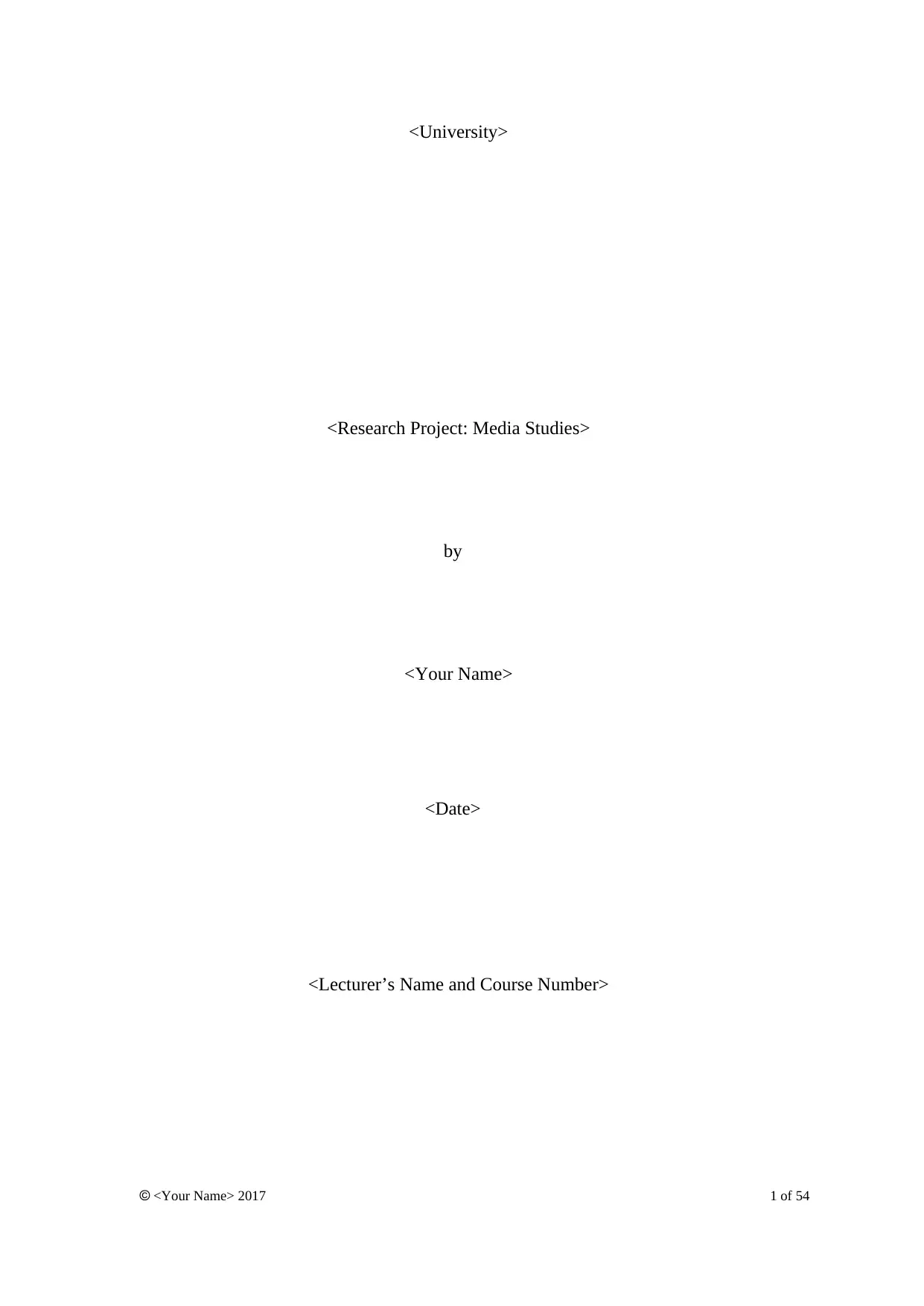
<University>
<Research Project: Media Studies>
by
<Your Name>
<Date>
<Lecturer’s Name and Course Number>
<Your Name> 2017 1 of 54
<Research Project: Media Studies>
by
<Your Name>
<Date>
<Lecturer’s Name and Course Number>
<Your Name> 2017 1 of 54
Paraphrase This Document
Need a fresh take? Get an instant paraphrase of this document with our AI Paraphraser
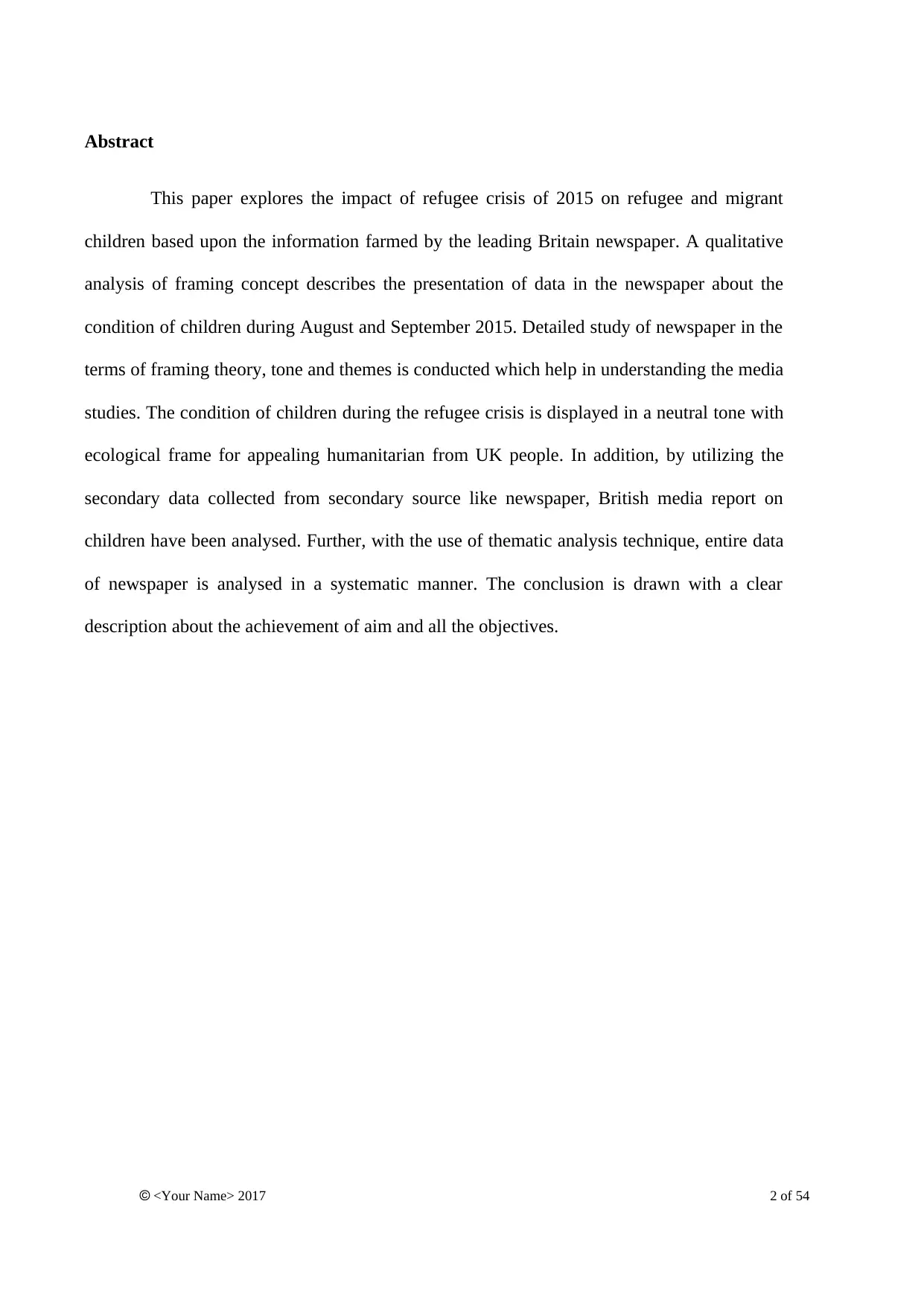
Abstract
This paper explores the impact of refugee crisis of 2015 on refugee and migrant
children based upon the information farmed by the leading Britain newspaper. A qualitative
analysis of framing concept describes the presentation of data in the newspaper about the
condition of children during August and September 2015. Detailed study of newspaper in the
terms of framing theory, tone and themes is conducted which help in understanding the media
studies. The condition of children during the refugee crisis is displayed in a neutral tone with
ecological frame for appealing humanitarian from UK people. In addition, by utilizing the
secondary data collected from secondary source like newspaper, British media report on
children have been analysed. Further, with the use of thematic analysis technique, entire data
of newspaper is analysed in a systematic manner. The conclusion is drawn with a clear
description about the achievement of aim and all the objectives.
<Your Name> 2017 2 of 54
This paper explores the impact of refugee crisis of 2015 on refugee and migrant
children based upon the information farmed by the leading Britain newspaper. A qualitative
analysis of framing concept describes the presentation of data in the newspaper about the
condition of children during August and September 2015. Detailed study of newspaper in the
terms of framing theory, tone and themes is conducted which help in understanding the media
studies. The condition of children during the refugee crisis is displayed in a neutral tone with
ecological frame for appealing humanitarian from UK people. In addition, by utilizing the
secondary data collected from secondary source like newspaper, British media report on
children have been analysed. Further, with the use of thematic analysis technique, entire data
of newspaper is analysed in a systematic manner. The conclusion is drawn with a clear
description about the achievement of aim and all the objectives.
<Your Name> 2017 2 of 54
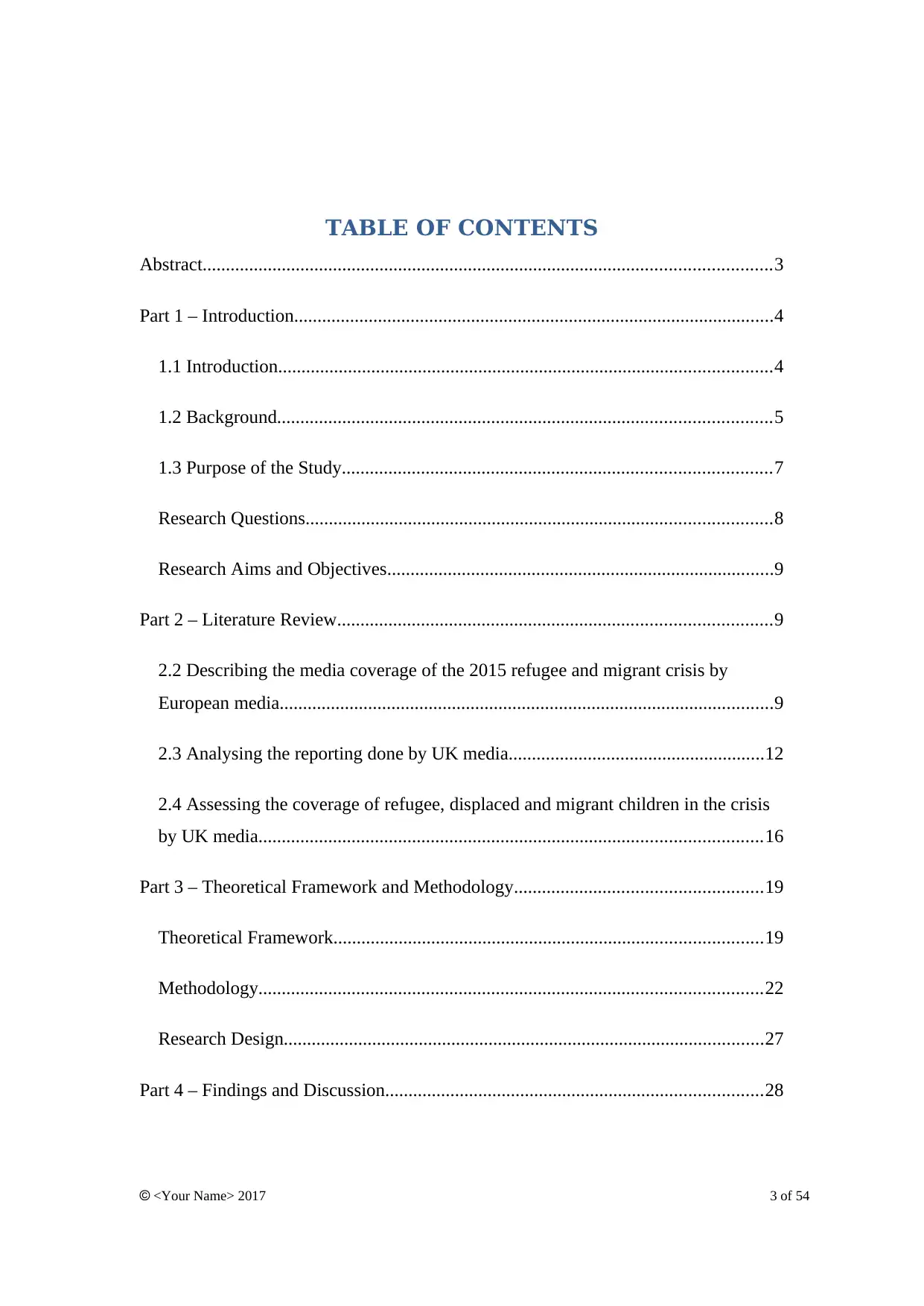
TABLE OF CONTENTS
Abstract..........................................................................................................................3
Part 1 – Introduction.......................................................................................................4
1.1 Introduction..........................................................................................................4
1.2 Background..........................................................................................................5
1.3 Purpose of the Study............................................................................................7
Research Questions....................................................................................................8
Research Aims and Objectives...................................................................................9
Part 2 – Literature Review.............................................................................................9
2.2 Describing the media coverage of the 2015 refugee and migrant crisis by
European media..........................................................................................................9
2.3 Analysing the reporting done by UK media.......................................................12
2.4 Assessing the coverage of refugee, displaced and migrant children in the crisis
by UK media............................................................................................................16
Part 3 – Theoretical Framework and Methodology.....................................................19
Theoretical Framework............................................................................................19
Methodology............................................................................................................22
Research Design.......................................................................................................27
Part 4 – Findings and Discussion.................................................................................28
<Your Name> 2017 3 of 54
Abstract..........................................................................................................................3
Part 1 – Introduction.......................................................................................................4
1.1 Introduction..........................................................................................................4
1.2 Background..........................................................................................................5
1.3 Purpose of the Study............................................................................................7
Research Questions....................................................................................................8
Research Aims and Objectives...................................................................................9
Part 2 – Literature Review.............................................................................................9
2.2 Describing the media coverage of the 2015 refugee and migrant crisis by
European media..........................................................................................................9
2.3 Analysing the reporting done by UK media.......................................................12
2.4 Assessing the coverage of refugee, displaced and migrant children in the crisis
by UK media............................................................................................................16
Part 3 – Theoretical Framework and Methodology.....................................................19
Theoretical Framework............................................................................................19
Methodology............................................................................................................22
Research Design.......................................................................................................27
Part 4 – Findings and Discussion.................................................................................28
<Your Name> 2017 3 of 54
⊘ This is a preview!⊘
Do you want full access?
Subscribe today to unlock all pages.

Trusted by 1+ million students worldwide
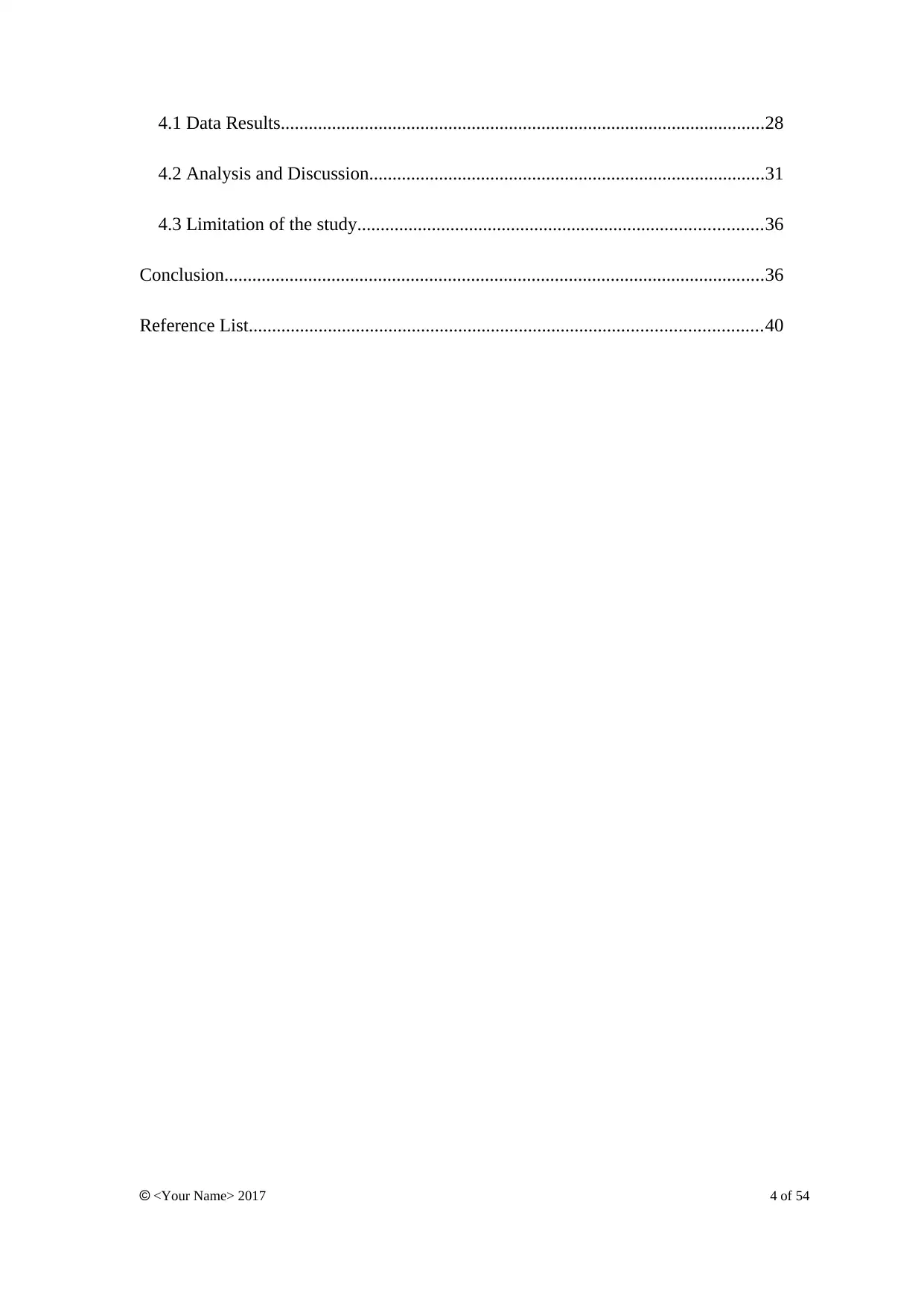
4.1 Data Results........................................................................................................28
4.2 Analysis and Discussion.....................................................................................31
4.3 Limitation of the study.......................................................................................36
Conclusion....................................................................................................................36
Reference List..............................................................................................................40
<Your Name> 2017 4 of 54
4.2 Analysis and Discussion.....................................................................................31
4.3 Limitation of the study.......................................................................................36
Conclusion....................................................................................................................36
Reference List..............................................................................................................40
<Your Name> 2017 4 of 54
Paraphrase This Document
Need a fresh take? Get an instant paraphrase of this document with our AI Paraphraser
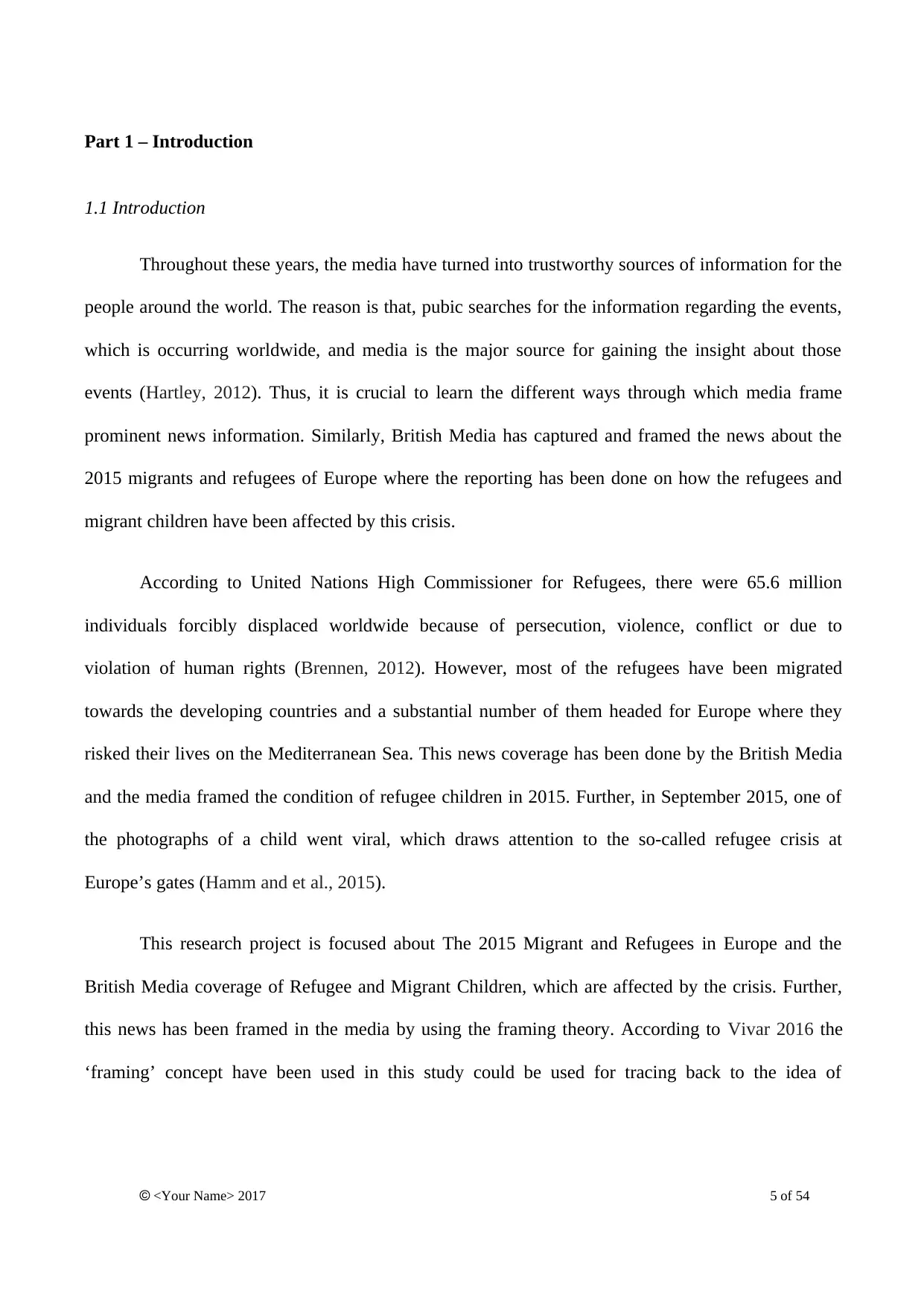
Part 1 – Introduction
1.1 Introduction
Throughout these years, the media have turned into trustworthy sources of information for the
people around the world. The reason is that, pubic searches for the information regarding the events,
which is occurring worldwide, and media is the major source for gaining the insight about those
events (Hartley, 2012). Thus, it is crucial to learn the different ways through which media frame
prominent news information. Similarly, British Media has captured and framed the news about the
2015 migrants and refugees of Europe where the reporting has been done on how the refugees and
migrant children have been affected by this crisis.
According to United Nations High Commissioner for Refugees, there were 65.6 million
individuals forcibly displaced worldwide because of persecution, violence, conflict or due to
violation of human rights (Brennen, 2012). However, most of the refugees have been migrated
towards the developing countries and a substantial number of them headed for Europe where they
risked their lives on the Mediterranean Sea. This news coverage has been done by the British Media
and the media framed the condition of refugee children in 2015. Further, in September 2015, one of
the photographs of a child went viral, which draws attention to the so-called refugee crisis at
Europe’s gates (Hamm and et al., 2015).
This research project is focused about The 2015 Migrant and Refugees in Europe and the
British Media coverage of Refugee and Migrant Children, which are affected by the crisis. Further,
this news has been framed in the media by using the framing theory. According to Vivar 2016 the
‘framing’ concept have been used in this study could be used for tracing back to the idea of
<Your Name> 2017 5 of 54
1.1 Introduction
Throughout these years, the media have turned into trustworthy sources of information for the
people around the world. The reason is that, pubic searches for the information regarding the events,
which is occurring worldwide, and media is the major source for gaining the insight about those
events (Hartley, 2012). Thus, it is crucial to learn the different ways through which media frame
prominent news information. Similarly, British Media has captured and framed the news about the
2015 migrants and refugees of Europe where the reporting has been done on how the refugees and
migrant children have been affected by this crisis.
According to United Nations High Commissioner for Refugees, there were 65.6 million
individuals forcibly displaced worldwide because of persecution, violence, conflict or due to
violation of human rights (Brennen, 2012). However, most of the refugees have been migrated
towards the developing countries and a substantial number of them headed for Europe where they
risked their lives on the Mediterranean Sea. This news coverage has been done by the British Media
and the media framed the condition of refugee children in 2015. Further, in September 2015, one of
the photographs of a child went viral, which draws attention to the so-called refugee crisis at
Europe’s gates (Hamm and et al., 2015).
This research project is focused about The 2015 Migrant and Refugees in Europe and the
British Media coverage of Refugee and Migrant Children, which are affected by the crisis. Further,
this news has been framed in the media by using the framing theory. According to Vivar 2016 the
‘framing’ concept have been used in this study could be used for tracing back to the idea of
<Your Name> 2017 5 of 54
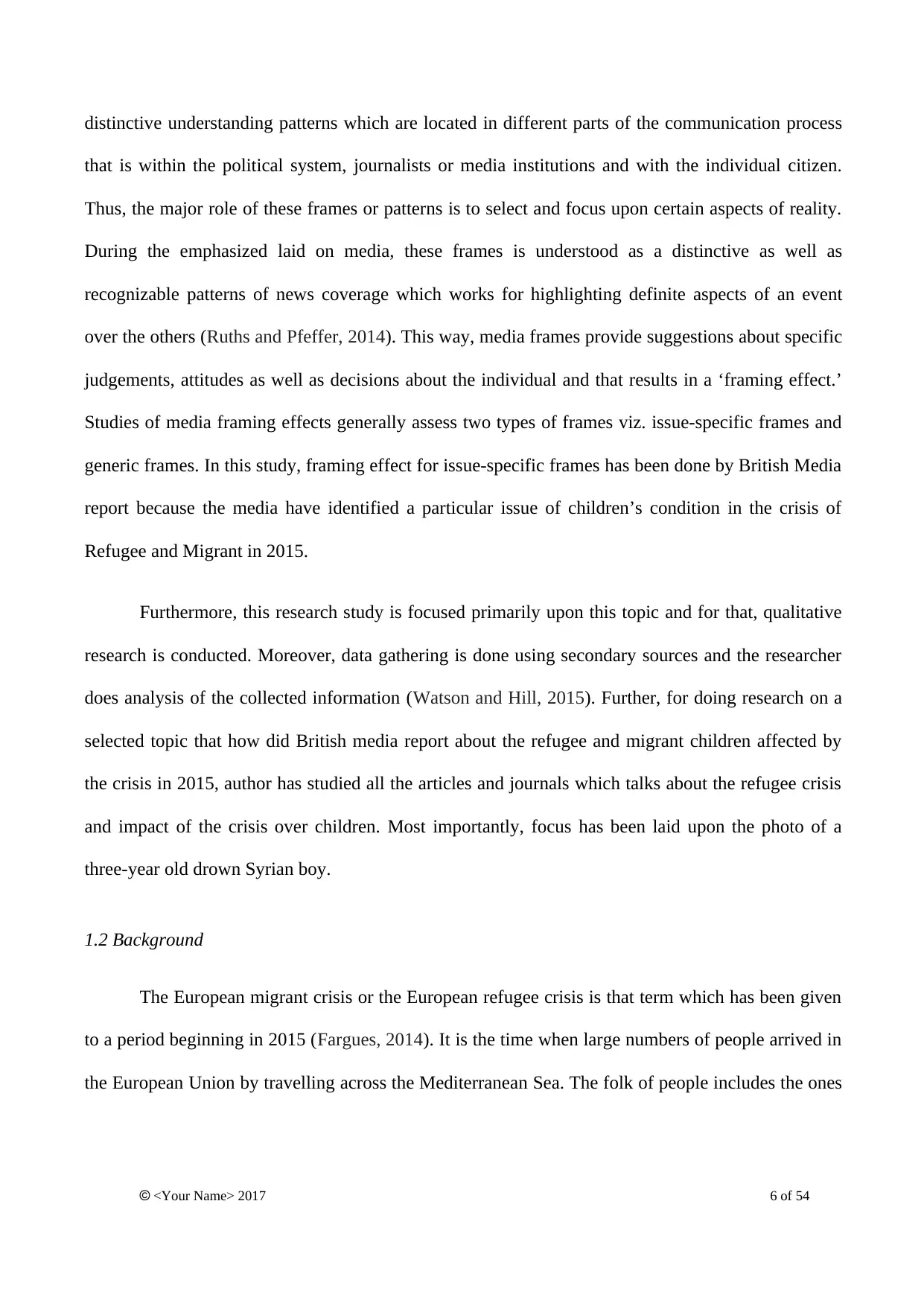
distinctive understanding patterns which are located in different parts of the communication process
that is within the political system, journalists or media institutions and with the individual citizen.
Thus, the major role of these frames or patterns is to select and focus upon certain aspects of reality.
During the emphasized laid on media, these frames is understood as a distinctive as well as
recognizable patterns of news coverage which works for highlighting definite aspects of an event
over the others (Ruths and Pfeffer, 2014). This way, media frames provide suggestions about specific
judgements, attitudes as well as decisions about the individual and that results in a ‘framing effect.’
Studies of media framing effects generally assess two types of frames viz. issue-specific frames and
generic frames. In this study, framing effect for issue-specific frames has been done by British Media
report because the media have identified a particular issue of children’s condition in the crisis of
Refugee and Migrant in 2015.
Furthermore, this research study is focused primarily upon this topic and for that, qualitative
research is conducted. Moreover, data gathering is done using secondary sources and the researcher
does analysis of the collected information (Watson and Hill, 2015). Further, for doing research on a
selected topic that how did British media report about the refugee and migrant children affected by
the crisis in 2015, author has studied all the articles and journals which talks about the refugee crisis
and impact of the crisis over children. Most importantly, focus has been laid upon the photo of a
three-year old drown Syrian boy.
1.2 Background
The European migrant crisis or the European refugee crisis is that term which has been given
to a period beginning in 2015 (Fargues, 2014). It is the time when large numbers of people arrived in
the European Union by travelling across the Mediterranean Sea. The folk of people includes the ones
<Your Name> 2017 6 of 54
that is within the political system, journalists or media institutions and with the individual citizen.
Thus, the major role of these frames or patterns is to select and focus upon certain aspects of reality.
During the emphasized laid on media, these frames is understood as a distinctive as well as
recognizable patterns of news coverage which works for highlighting definite aspects of an event
over the others (Ruths and Pfeffer, 2014). This way, media frames provide suggestions about specific
judgements, attitudes as well as decisions about the individual and that results in a ‘framing effect.’
Studies of media framing effects generally assess two types of frames viz. issue-specific frames and
generic frames. In this study, framing effect for issue-specific frames has been done by British Media
report because the media have identified a particular issue of children’s condition in the crisis of
Refugee and Migrant in 2015.
Furthermore, this research study is focused primarily upon this topic and for that, qualitative
research is conducted. Moreover, data gathering is done using secondary sources and the researcher
does analysis of the collected information (Watson and Hill, 2015). Further, for doing research on a
selected topic that how did British media report about the refugee and migrant children affected by
the crisis in 2015, author has studied all the articles and journals which talks about the refugee crisis
and impact of the crisis over children. Most importantly, focus has been laid upon the photo of a
three-year old drown Syrian boy.
1.2 Background
The European migrant crisis or the European refugee crisis is that term which has been given
to a period beginning in 2015 (Fargues, 2014). It is the time when large numbers of people arrived in
the European Union by travelling across the Mediterranean Sea. The folk of people includes the ones
<Your Name> 2017 6 of 54
⊘ This is a preview!⊘
Do you want full access?
Subscribe today to unlock all pages.

Trusted by 1+ million students worldwide
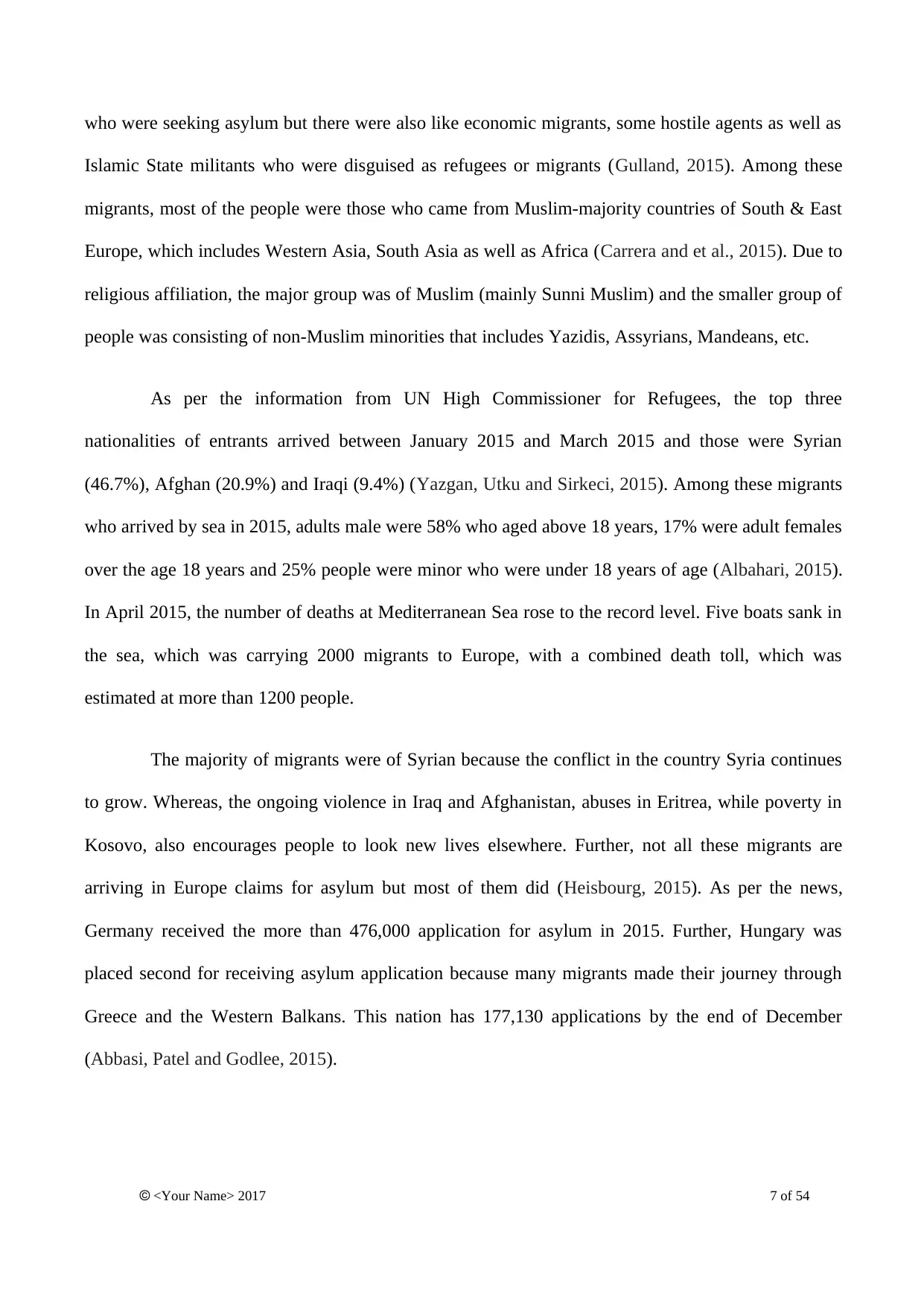
who were seeking asylum but there were also like economic migrants, some hostile agents as well as
Islamic State militants who were disguised as refugees or migrants (Gulland, 2015). Among these
migrants, most of the people were those who came from Muslim-majority countries of South & East
Europe, which includes Western Asia, South Asia as well as Africa (Carrera and et al., 2015). Due to
religious affiliation, the major group was of Muslim (mainly Sunni Muslim) and the smaller group of
people was consisting of non-Muslim minorities that includes Yazidis, Assyrians, Mandeans, etc.
As per the information from UN High Commissioner for Refugees, the top three
nationalities of entrants arrived between January 2015 and March 2015 and those were Syrian
(46.7%), Afghan (20.9%) and Iraqi (9.4%) (Yazgan, Utku and Sirkeci, 2015). Among these migrants
who arrived by sea in 2015, adults male were 58% who aged above 18 years, 17% were adult females
over the age 18 years and 25% people were minor who were under 18 years of age (Albahari, 2015).
In April 2015, the number of deaths at Mediterranean Sea rose to the record level. Five boats sank in
the sea, which was carrying 2000 migrants to Europe, with a combined death toll, which was
estimated at more than 1200 people.
The majority of migrants were of Syrian because the conflict in the country Syria continues
to grow. Whereas, the ongoing violence in Iraq and Afghanistan, abuses in Eritrea, while poverty in
Kosovo, also encourages people to look new lives elsewhere. Further, not all these migrants are
arriving in Europe claims for asylum but most of them did (Heisbourg, 2015). As per the news,
Germany received the more than 476,000 application for asylum in 2015. Further, Hungary was
placed second for receiving asylum application because many migrants made their journey through
Greece and the Western Balkans. This nation has 177,130 applications by the end of December
(Abbasi, Patel and Godlee, 2015).
<Your Name> 2017 7 of 54
Islamic State militants who were disguised as refugees or migrants (Gulland, 2015). Among these
migrants, most of the people were those who came from Muslim-majority countries of South & East
Europe, which includes Western Asia, South Asia as well as Africa (Carrera and et al., 2015). Due to
religious affiliation, the major group was of Muslim (mainly Sunni Muslim) and the smaller group of
people was consisting of non-Muslim minorities that includes Yazidis, Assyrians, Mandeans, etc.
As per the information from UN High Commissioner for Refugees, the top three
nationalities of entrants arrived between January 2015 and March 2015 and those were Syrian
(46.7%), Afghan (20.9%) and Iraqi (9.4%) (Yazgan, Utku and Sirkeci, 2015). Among these migrants
who arrived by sea in 2015, adults male were 58% who aged above 18 years, 17% were adult females
over the age 18 years and 25% people were minor who were under 18 years of age (Albahari, 2015).
In April 2015, the number of deaths at Mediterranean Sea rose to the record level. Five boats sank in
the sea, which was carrying 2000 migrants to Europe, with a combined death toll, which was
estimated at more than 1200 people.
The majority of migrants were of Syrian because the conflict in the country Syria continues
to grow. Whereas, the ongoing violence in Iraq and Afghanistan, abuses in Eritrea, while poverty in
Kosovo, also encourages people to look new lives elsewhere. Further, not all these migrants are
arriving in Europe claims for asylum but most of them did (Heisbourg, 2015). As per the news,
Germany received the more than 476,000 application for asylum in 2015. Further, Hungary was
placed second for receiving asylum application because many migrants made their journey through
Greece and the Western Balkans. This nation has 177,130 applications by the end of December
(Abbasi, Patel and Godlee, 2015).
<Your Name> 2017 7 of 54
Paraphrase This Document
Need a fresh take? Get an instant paraphrase of this document with our AI Paraphraser
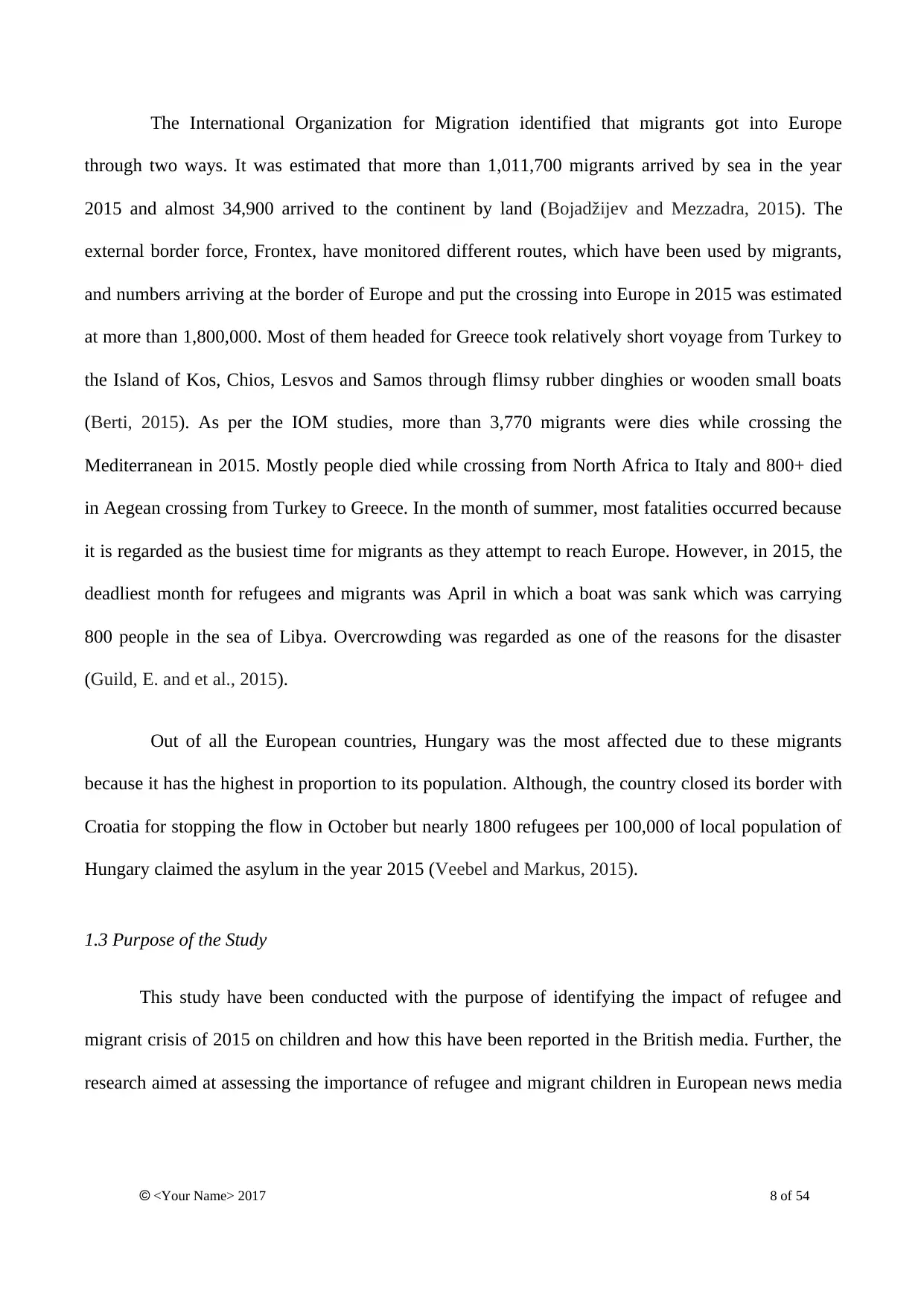
The International Organization for Migration identified that migrants got into Europe
through two ways. It was estimated that more than 1,011,700 migrants arrived by sea in the year
2015 and almost 34,900 arrived to the continent by land (Bojadžijev and Mezzadra, 2015). The
external border force, Frontex, have monitored different routes, which have been used by migrants,
and numbers arriving at the border of Europe and put the crossing into Europe in 2015 was estimated
at more than 1,800,000. Most of them headed for Greece took relatively short voyage from Turkey to
the Island of Kos, Chios, Lesvos and Samos through flimsy rubber dinghies or wooden small boats
(Berti, 2015). As per the IOM studies, more than 3,770 migrants were dies while crossing the
Mediterranean in 2015. Mostly people died while crossing from North Africa to Italy and 800+ died
in Aegean crossing from Turkey to Greece. In the month of summer, most fatalities occurred because
it is regarded as the busiest time for migrants as they attempt to reach Europe. However, in 2015, the
deadliest month for refugees and migrants was April in which a boat was sank which was carrying
800 people in the sea of Libya. Overcrowding was regarded as one of the reasons for the disaster
(Guild, E. and et al., 2015).
Out of all the European countries, Hungary was the most affected due to these migrants
because it has the highest in proportion to its population. Although, the country closed its border with
Croatia for stopping the flow in October but nearly 1800 refugees per 100,000 of local population of
Hungary claimed the asylum in the year 2015 (Veebel and Markus, 2015).
1.3 Purpose of the Study
This study have been conducted with the purpose of identifying the impact of refugee and
migrant crisis of 2015 on children and how this have been reported in the British media. Further, the
research aimed at assessing the importance of refugee and migrant children in European news media
<Your Name> 2017 8 of 54
through two ways. It was estimated that more than 1,011,700 migrants arrived by sea in the year
2015 and almost 34,900 arrived to the continent by land (Bojadžijev and Mezzadra, 2015). The
external border force, Frontex, have monitored different routes, which have been used by migrants,
and numbers arriving at the border of Europe and put the crossing into Europe in 2015 was estimated
at more than 1,800,000. Most of them headed for Greece took relatively short voyage from Turkey to
the Island of Kos, Chios, Lesvos and Samos through flimsy rubber dinghies or wooden small boats
(Berti, 2015). As per the IOM studies, more than 3,770 migrants were dies while crossing the
Mediterranean in 2015. Mostly people died while crossing from North Africa to Italy and 800+ died
in Aegean crossing from Turkey to Greece. In the month of summer, most fatalities occurred because
it is regarded as the busiest time for migrants as they attempt to reach Europe. However, in 2015, the
deadliest month for refugees and migrants was April in which a boat was sank which was carrying
800 people in the sea of Libya. Overcrowding was regarded as one of the reasons for the disaster
(Guild, E. and et al., 2015).
Out of all the European countries, Hungary was the most affected due to these migrants
because it has the highest in proportion to its population. Although, the country closed its border with
Croatia for stopping the flow in October but nearly 1800 refugees per 100,000 of local population of
Hungary claimed the asylum in the year 2015 (Veebel and Markus, 2015).
1.3 Purpose of the Study
This study have been conducted with the purpose of identifying the impact of refugee and
migrant crisis of 2015 on children and how this have been reported in the British media. Further, the
research aimed at assessing the importance of refugee and migrant children in European news media
<Your Name> 2017 8 of 54
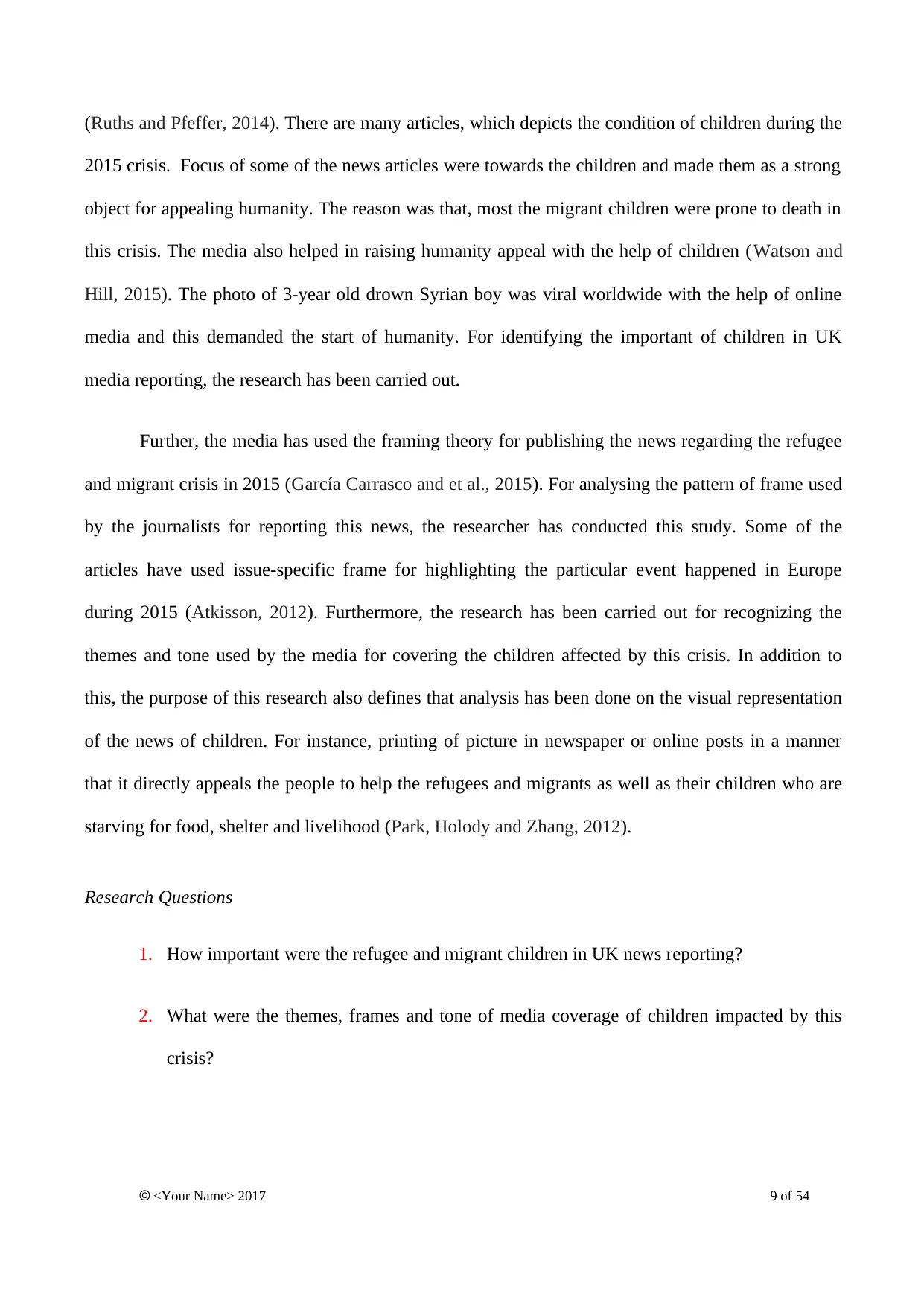
(Ruths and Pfeffer, 2014). There are many articles, which depicts the condition of children during the
2015 crisis. Focus of some of the news articles were towards the children and made them as a strong
object for appealing humanity. The reason was that, most the migrant children were prone to death in
this crisis. The media also helped in raising humanity appeal with the help of children (Watson and
Hill, 2015). The photo of 3-year old drown Syrian boy was viral worldwide with the help of online
media and this demanded the start of humanity. For identifying the important of children in UK
media reporting, the research has been carried out.
Further, the media has used the framing theory for publishing the news regarding the refugee
and migrant crisis in 2015 (García Carrasco and et al., 2015). For analysing the pattern of frame used
by the journalists for reporting this news, the researcher has conducted this study. Some of the
articles have used issue-specific frame for highlighting the particular event happened in Europe
during 2015 (Atkisson, 2012). Furthermore, the research has been carried out for recognizing the
themes and tone used by the media for covering the children affected by this crisis. In addition to
this, the purpose of this research also defines that analysis has been done on the visual representation
of the news of children. For instance, printing of picture in newspaper or online posts in a manner
that it directly appeals the people to help the refugees and migrants as well as their children who are
starving for food, shelter and livelihood (Park, Holody and Zhang, 2012).
Research Questions
1. How important were the refugee and migrant children in UK news reporting?
2. What were the themes, frames and tone of media coverage of children impacted by this
crisis?
<Your Name> 2017 9 of 54
2015 crisis. Focus of some of the news articles were towards the children and made them as a strong
object for appealing humanity. The reason was that, most the migrant children were prone to death in
this crisis. The media also helped in raising humanity appeal with the help of children (Watson and
Hill, 2015). The photo of 3-year old drown Syrian boy was viral worldwide with the help of online
media and this demanded the start of humanity. For identifying the important of children in UK
media reporting, the research has been carried out.
Further, the media has used the framing theory for publishing the news regarding the refugee
and migrant crisis in 2015 (García Carrasco and et al., 2015). For analysing the pattern of frame used
by the journalists for reporting this news, the researcher has conducted this study. Some of the
articles have used issue-specific frame for highlighting the particular event happened in Europe
during 2015 (Atkisson, 2012). Furthermore, the research has been carried out for recognizing the
themes and tone used by the media for covering the children affected by this crisis. In addition to
this, the purpose of this research also defines that analysis has been done on the visual representation
of the news of children. For instance, printing of picture in newspaper or online posts in a manner
that it directly appeals the people to help the refugees and migrants as well as their children who are
starving for food, shelter and livelihood (Park, Holody and Zhang, 2012).
Research Questions
1. How important were the refugee and migrant children in UK news reporting?
2. What were the themes, frames and tone of media coverage of children impacted by this
crisis?
<Your Name> 2017 9 of 54
⊘ This is a preview!⊘
Do you want full access?
Subscribe today to unlock all pages.

Trusted by 1+ million students worldwide
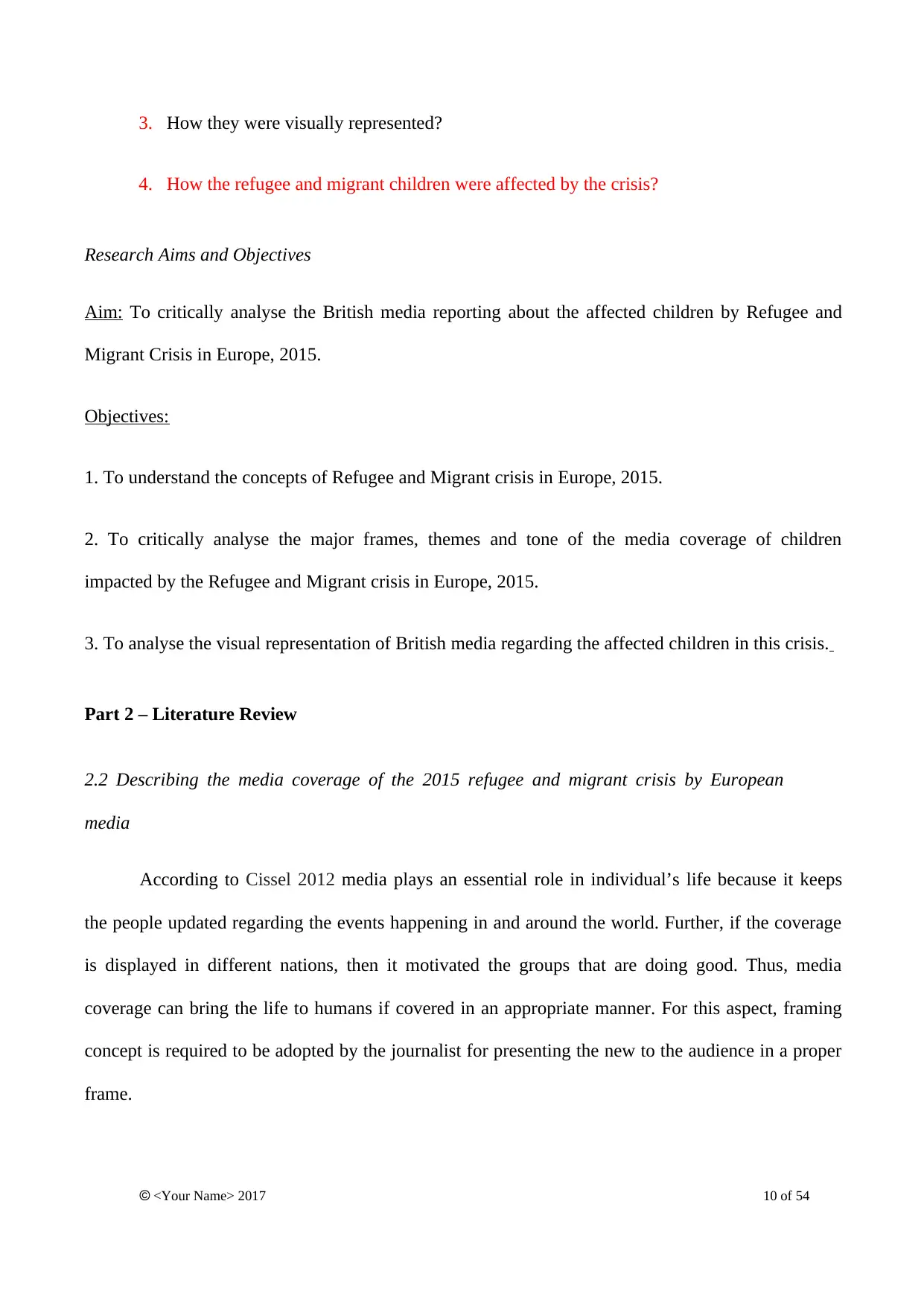
3. How they were visually represented?
4. How the refugee and migrant children were affected by the crisis?
Research Aims and Objectives
Aim: To critically analyse the British media reporting about the affected children by Refugee and
Migrant Crisis in Europe, 2015.
Objectives:
1. To understand the concepts of Refugee and Migrant crisis in Europe, 2015.
2. To critically analyse the major frames, themes and tone of the media coverage of children
impacted by the Refugee and Migrant crisis in Europe, 2015.
3. To analyse the visual representation of British media regarding the affected children in this crisis.
Part 2 – Literature Review
2.2 Describing the media coverage of the 2015 refugee and migrant crisis by European
media
According to Cissel 2012 media plays an essential role in individual’s life because it keeps
the people updated regarding the events happening in and around the world. Further, if the coverage
is displayed in different nations, then it motivated the groups that are doing good. Thus, media
coverage can bring the life to humans if covered in an appropriate manner. For this aspect, framing
concept is required to be adopted by the journalist for presenting the new to the audience in a proper
frame.
<Your Name> 2017 10 of 54
4. How the refugee and migrant children were affected by the crisis?
Research Aims and Objectives
Aim: To critically analyse the British media reporting about the affected children by Refugee and
Migrant Crisis in Europe, 2015.
Objectives:
1. To understand the concepts of Refugee and Migrant crisis in Europe, 2015.
2. To critically analyse the major frames, themes and tone of the media coverage of children
impacted by the Refugee and Migrant crisis in Europe, 2015.
3. To analyse the visual representation of British media regarding the affected children in this crisis.
Part 2 – Literature Review
2.2 Describing the media coverage of the 2015 refugee and migrant crisis by European
media
According to Cissel 2012 media plays an essential role in individual’s life because it keeps
the people updated regarding the events happening in and around the world. Further, if the coverage
is displayed in different nations, then it motivated the groups that are doing good. Thus, media
coverage can bring the life to humans if covered in an appropriate manner. For this aspect, framing
concept is required to be adopted by the journalist for presenting the new to the audience in a proper
frame.
<Your Name> 2017 10 of 54
Paraphrase This Document
Need a fresh take? Get an instant paraphrase of this document with our AI Paraphraser
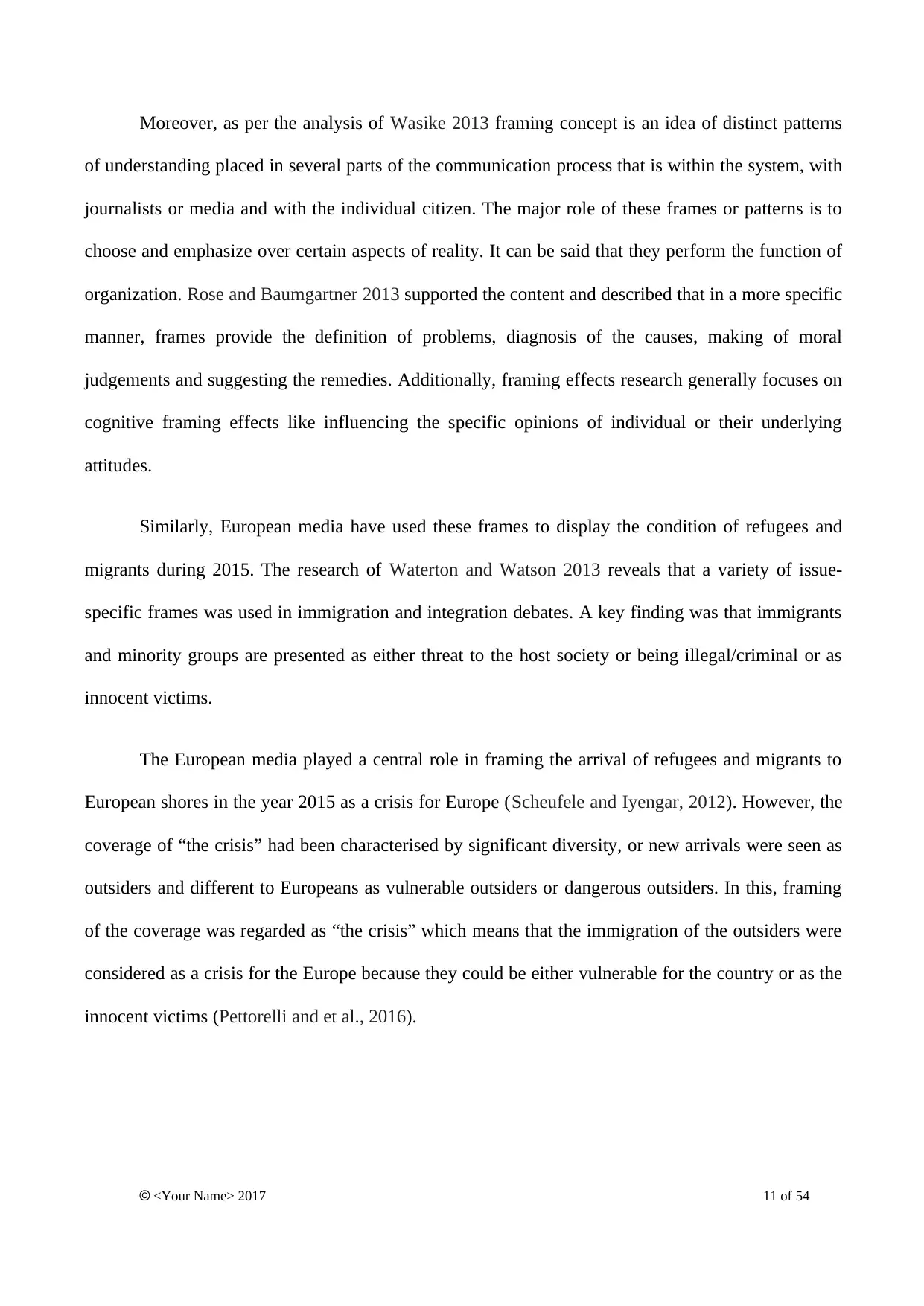
Moreover, as per the analysis of Wasike 2013 framing concept is an idea of distinct patterns
of understanding placed in several parts of the communication process that is within the system, with
journalists or media and with the individual citizen. The major role of these frames or patterns is to
choose and emphasize over certain aspects of reality. It can be said that they perform the function of
organization. Rose and Baumgartner 2013 supported the content and described that in a more specific
manner, frames provide the definition of problems, diagnosis of the causes, making of moral
judgements and suggesting the remedies. Additionally, framing effects research generally focuses on
cognitive framing effects like influencing the specific opinions of individual or their underlying
attitudes.
Similarly, European media have used these frames to display the condition of refugees and
migrants during 2015. The research of Waterton and Watson 2013 reveals that a variety of issue-
specific frames was used in immigration and integration debates. A key finding was that immigrants
and minority groups are presented as either threat to the host society or being illegal/criminal or as
innocent victims.
The European media played a central role in framing the arrival of refugees and migrants to
European shores in the year 2015 as a crisis for Europe (Scheufele and Iyengar, 2012). However, the
coverage of “the crisis” had been characterised by significant diversity, or new arrivals were seen as
outsiders and different to Europeans as vulnerable outsiders or dangerous outsiders. In this, framing
of the coverage was regarded as “the crisis” which means that the immigration of the outsiders were
considered as a crisis for the Europe because they could be either vulnerable for the country or as the
innocent victims (Pettorelli and et al., 2016).
<Your Name> 2017 11 of 54
of understanding placed in several parts of the communication process that is within the system, with
journalists or media and with the individual citizen. The major role of these frames or patterns is to
choose and emphasize over certain aspects of reality. It can be said that they perform the function of
organization. Rose and Baumgartner 2013 supported the content and described that in a more specific
manner, frames provide the definition of problems, diagnosis of the causes, making of moral
judgements and suggesting the remedies. Additionally, framing effects research generally focuses on
cognitive framing effects like influencing the specific opinions of individual or their underlying
attitudes.
Similarly, European media have used these frames to display the condition of refugees and
migrants during 2015. The research of Waterton and Watson 2013 reveals that a variety of issue-
specific frames was used in immigration and integration debates. A key finding was that immigrants
and minority groups are presented as either threat to the host society or being illegal/criminal or as
innocent victims.
The European media played a central role in framing the arrival of refugees and migrants to
European shores in the year 2015 as a crisis for Europe (Scheufele and Iyengar, 2012). However, the
coverage of “the crisis” had been characterised by significant diversity, or new arrivals were seen as
outsiders and different to Europeans as vulnerable outsiders or dangerous outsiders. In this, framing
of the coverage was regarded as “the crisis” which means that the immigration of the outsiders were
considered as a crisis for the Europe because they could be either vulnerable for the country or as the
innocent victims (Pettorelli and et al., 2016).
<Your Name> 2017 11 of 54
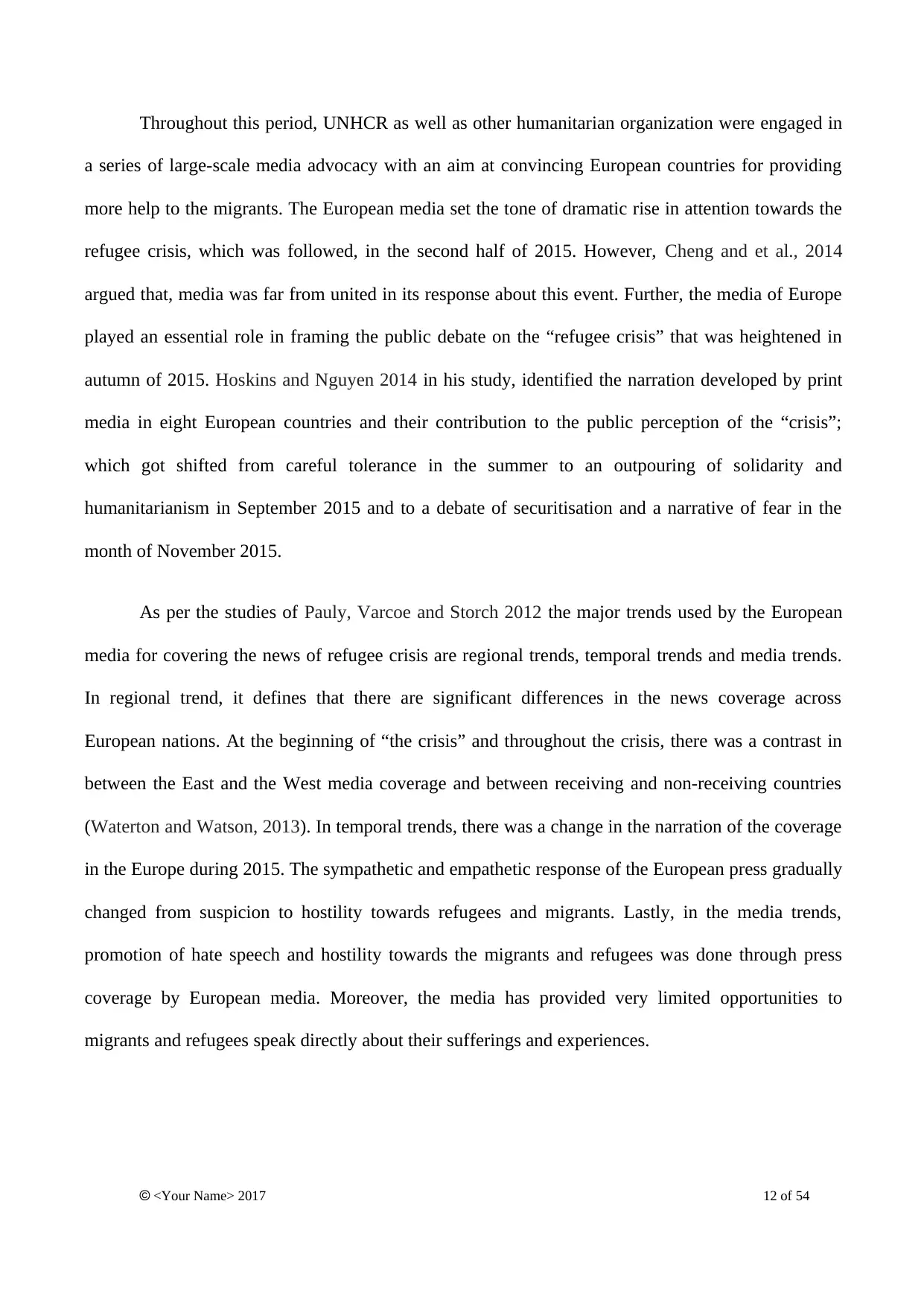
Throughout this period, UNHCR as well as other humanitarian organization were engaged in
a series of large-scale media advocacy with an aim at convincing European countries for providing
more help to the migrants. The European media set the tone of dramatic rise in attention towards the
refugee crisis, which was followed, in the second half of 2015. However, Cheng and et al., 2014
argued that, media was far from united in its response about this event. Further, the media of Europe
played an essential role in framing the public debate on the “refugee crisis” that was heightened in
autumn of 2015. Hoskins and Nguyen 2014 in his study, identified the narration developed by print
media in eight European countries and their contribution to the public perception of the “crisis”;
which got shifted from careful tolerance in the summer to an outpouring of solidarity and
humanitarianism in September 2015 and to a debate of securitisation and a narrative of fear in the
month of November 2015.
As per the studies of Pauly, Varcoe and Storch 2012 the major trends used by the European
media for covering the news of refugee crisis are regional trends, temporal trends and media trends.
In regional trend, it defines that there are significant differences in the news coverage across
European nations. At the beginning of “the crisis” and throughout the crisis, there was a contrast in
between the East and the West media coverage and between receiving and non-receiving countries
(Waterton and Watson, 2013). In temporal trends, there was a change in the narration of the coverage
in the Europe during 2015. The sympathetic and empathetic response of the European press gradually
changed from suspicion to hostility towards refugees and migrants. Lastly, in the media trends,
promotion of hate speech and hostility towards the migrants and refugees was done through press
coverage by European media. Moreover, the media has provided very limited opportunities to
migrants and refugees speak directly about their sufferings and experiences.
<Your Name> 2017 12 of 54
a series of large-scale media advocacy with an aim at convincing European countries for providing
more help to the migrants. The European media set the tone of dramatic rise in attention towards the
refugee crisis, which was followed, in the second half of 2015. However, Cheng and et al., 2014
argued that, media was far from united in its response about this event. Further, the media of Europe
played an essential role in framing the public debate on the “refugee crisis” that was heightened in
autumn of 2015. Hoskins and Nguyen 2014 in his study, identified the narration developed by print
media in eight European countries and their contribution to the public perception of the “crisis”;
which got shifted from careful tolerance in the summer to an outpouring of solidarity and
humanitarianism in September 2015 and to a debate of securitisation and a narrative of fear in the
month of November 2015.
As per the studies of Pauly, Varcoe and Storch 2012 the major trends used by the European
media for covering the news of refugee crisis are regional trends, temporal trends and media trends.
In regional trend, it defines that there are significant differences in the news coverage across
European nations. At the beginning of “the crisis” and throughout the crisis, there was a contrast in
between the East and the West media coverage and between receiving and non-receiving countries
(Waterton and Watson, 2013). In temporal trends, there was a change in the narration of the coverage
in the Europe during 2015. The sympathetic and empathetic response of the European press gradually
changed from suspicion to hostility towards refugees and migrants. Lastly, in the media trends,
promotion of hate speech and hostility towards the migrants and refugees was done through press
coverage by European media. Moreover, the media has provided very limited opportunities to
migrants and refugees speak directly about their sufferings and experiences.
<Your Name> 2017 12 of 54
⊘ This is a preview!⊘
Do you want full access?
Subscribe today to unlock all pages.

Trusted by 1+ million students worldwide
1 out of 54
Your All-in-One AI-Powered Toolkit for Academic Success.
+13062052269
info@desklib.com
Available 24*7 on WhatsApp / Email
![[object Object]](/_next/static/media/star-bottom.7253800d.svg)
Unlock your academic potential
Copyright © 2020–2025 A2Z Services. All Rights Reserved. Developed and managed by ZUCOL.

